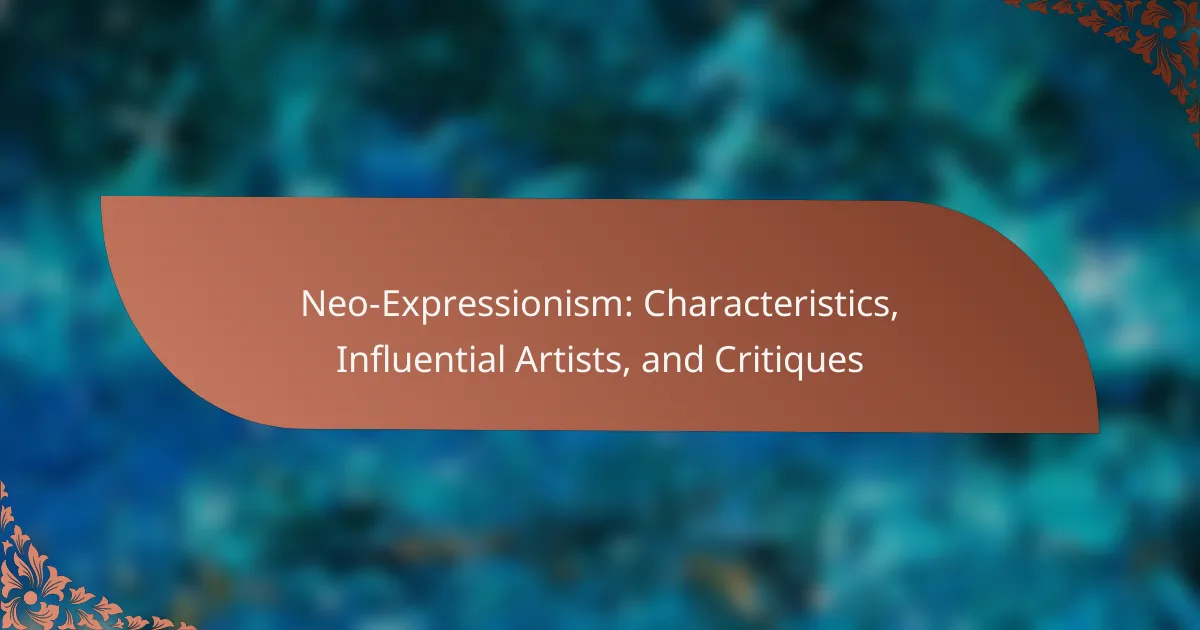Neo-Expressionism offers a vibrant exploration of human emotion through art, characterised by bold colours and dynamic forms. This article examines its defining characteristics, highlights influential artists like Jean-Michel Basquiat and Anselm Kiefer, and addresses critiques regarding originality and commercialism. By analysing these elements, readers can gain a deeper understanding of the movement’s impact on contemporary art.
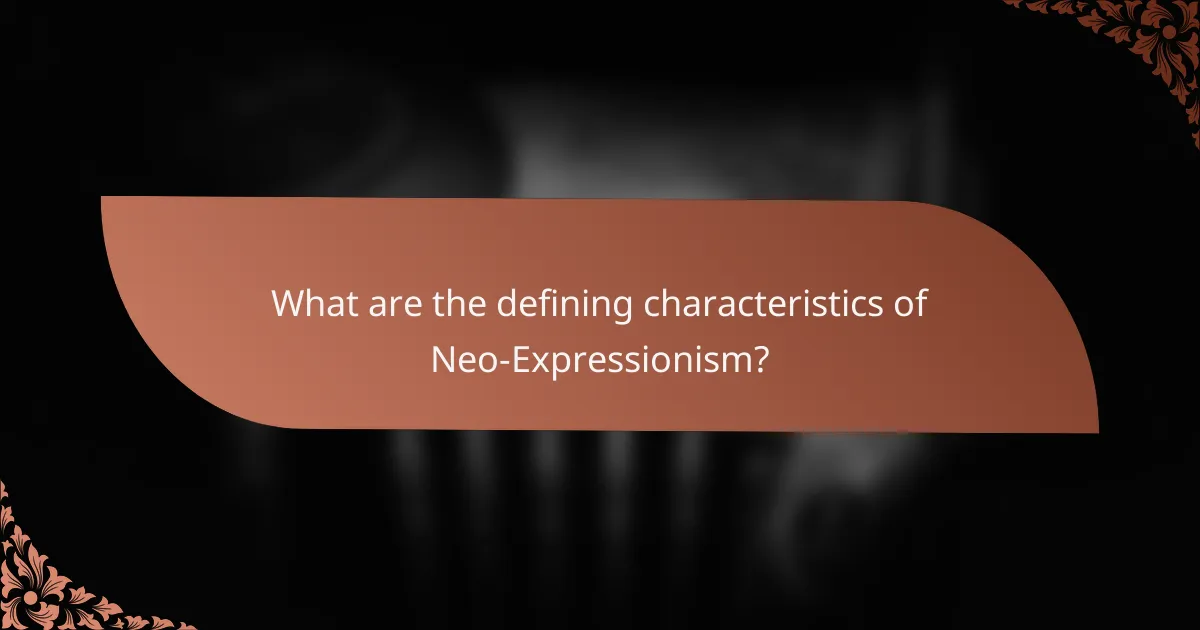
What are the defining characteristics of Neo-Expressionism?
Neo-Expressionism is characterised by vivid colours, emotional intensity, and a focus on the human experience. This movement emerged in the late 20th century, rejecting minimalism and abstraction. Influential artists include Jean-Michel Basquiat and Anselm Kiefer, known for their expressive styles. Critiques often highlight its commercialism and reliance on past styles, raising questions about authenticity.
How does Neo-Expressionism differ from other art movements?
Neo-Expressionism emphasises emotional intensity and personal expression, distinguishing it from other art movements. Unlike Minimalism’s focus on simplicity, Neo-Expressionism embraces vibrant colours and dynamic forms. Influential artists like Jean-Michel Basquiat and Anselm Kiefer prioritise subjective experience over objective representation. This movement often critiques societal issues, contrasting with the detached observations of earlier styles like Conceptual Art.
What role does emotion play in Neo-Expressionist works?
Emotion is central to Neo-Expressionist works, driving the intense visual language and personal narratives. Artists like Anselm Kiefer and Julian Schnabel use vibrant colours and exaggerated forms to evoke feelings, reflecting their inner turmoil and societal critiques. This emotional depth distinguishes Neo-Expressionism from earlier movements, emphasising subjective experience over objective representation. The movement’s focus on raw emotion often challenges viewers, inviting them to engage with complex themes of identity, trauma, and history.
Which themes are commonly explored in Neo-Expressionist art?
Neo-Expressionist art commonly explores themes of emotional intensity, identity, and social critique. Artists often depict raw human experiences, challenging traditional aesthetics. This movement frequently incorporates vivid colours and distorted forms to convey feelings. Notable themes include alienation, trauma, and the human condition, reflecting the complexities of contemporary life.
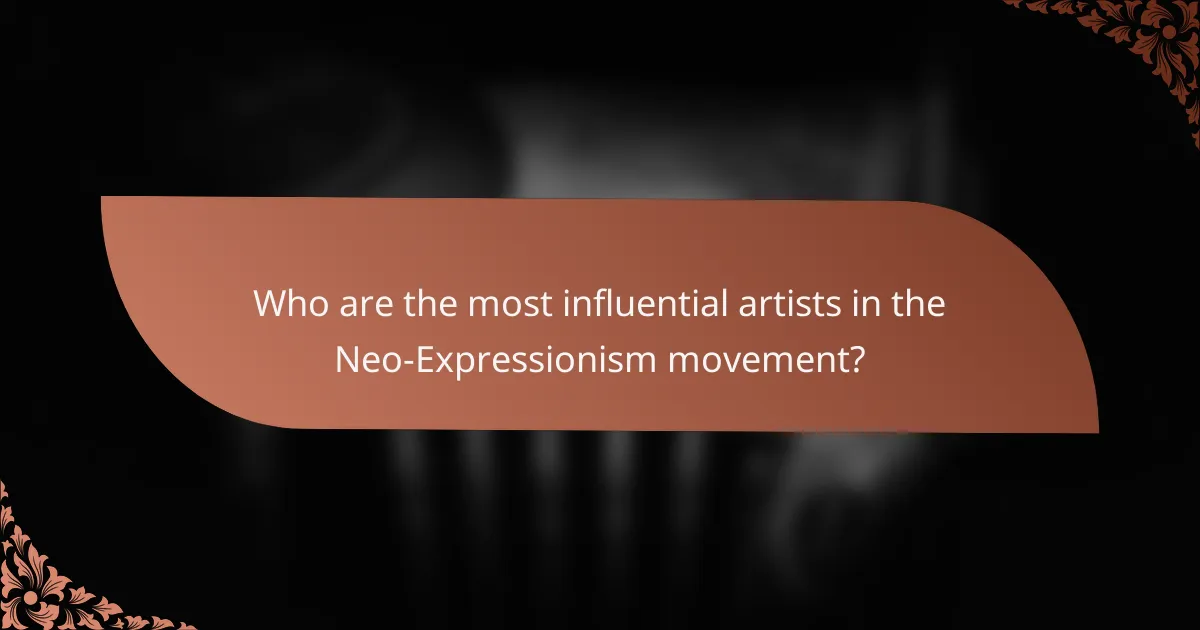
Who are the most influential artists in the Neo-Expressionism movement?
The most influential artists in the Neo-Expressionism movement include Jean-Michel Basquiat, Julian Schnabel, and Anselm Kiefer. These artists are known for their emotional intensity and vivid colours. Jean-Michel Basquiat’s work often reflects social commentary and identity, while Julian Schnabel is recognised for his innovative use of materials. Anselm Kiefer’s pieces explore themes of history and memory, showcasing a unique blend of symbolism and abstraction. Each artist has distinct attributes that contributed to the movement’s resurgence in the 1980s.
What contributions did Jean-Michel Basquiat make to Neo-Expressionism?
Jean-Michel Basquiat significantly influenced Neo-Expressionism through his unique blend of street art, symbolism, and raw emotion. His work challenged traditional art forms and addressed social issues like race and identity. Basquiat’s use of vibrant colours and expressive brushwork became hallmarks of the movement. He incorporated text and symbols, creating a dialogue between his art and the viewer. His legacy continues to inspire contemporary artists, reinforcing Neo-Expressionism’s impact on modern art.
How did Anselm Kiefer shape the Neo-Expressionist landscape?
Anselm Kiefer significantly influenced the Neo-Expressionist landscape through his unique approach to materials and themes. His use of heavy textures and mixed media embodies the movement’s emotional intensity. Kiefer’s exploration of history and mythology adds depth, prompting viewers to confront complex narratives. His large-scale works challenge traditional aesthetics, merging abstraction with figurative elements, which reshaped artistic boundaries within Neo-Expressionism.
Which emerging artists are redefining Neo-Expressionism today?
Several emerging artists are redefining Neo-Expressionism today, including Julie Mehretu, who blends abstraction with social commentary, and Mark Bradford, known for his large-scale collages. Other notable figures are Kehinde Wiley, who challenges traditional portraiture, and Njideka Akunyili Crosby, who incorporates personal narratives into her work. These artists share a commitment to exploring identity, culture, and societal issues through vibrant, emotive styles.
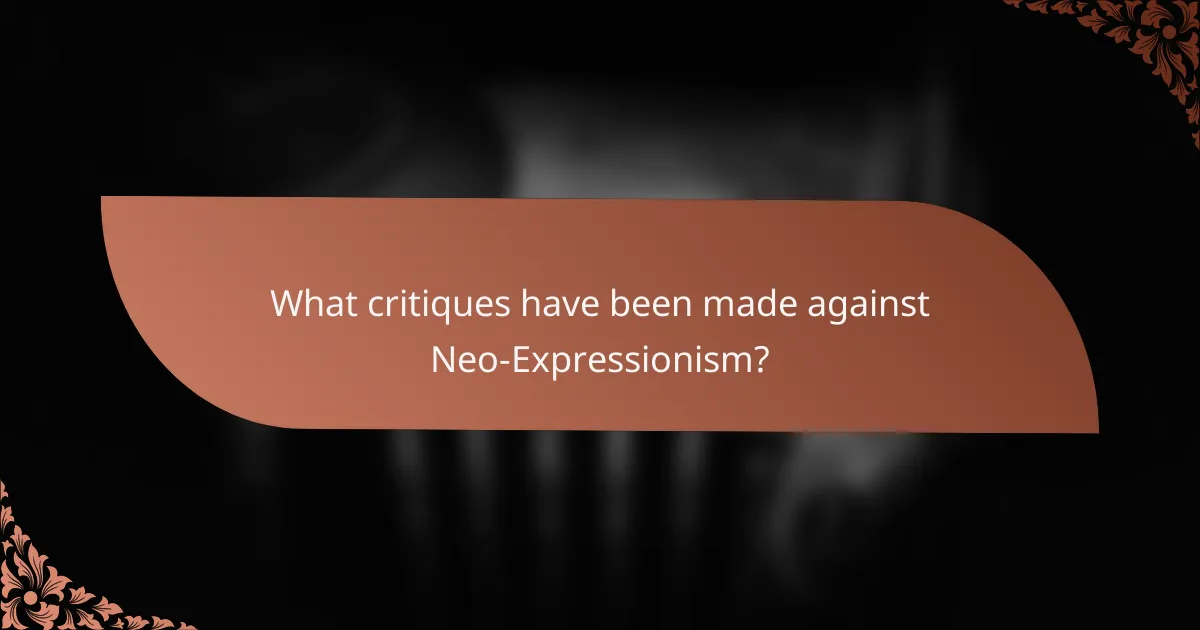
What critiques have been made against Neo-Expressionism?
Critiques of Neo-Expressionism often focus on its perceived lack of originality and depth. Critics argue that the movement relies heavily on emotional expression without substantial meaning. Some view it as a reactionary response to minimalism, lacking the innovation of earlier art movements. Additionally, the commercial success of Neo-Expressionist artists raises concerns about authenticity and artistic integrity. The movement’s emphasis on individualism can lead to a disconnect from broader social issues, limiting its relevance in contemporary discourse.
How do critics view the commercialization of Neo-Expressionist art?
Critics often view the commercialization of Neo-Expressionist art as a dilution of its original intent. They argue that the movement, which emerged as a reaction against the conceptual art of the 1970s, is now exploited for profit. This commercialization can lead to a loss of authenticity and emotional depth, as artists may prioritise marketability over genuine expression. Moreover, critics highlight that the focus on commercial success may overshadow the movement’s core themes of individuality and emotional intensity. As a result, Neo-Expressionism risks becoming a mere commodity rather than a profound artistic statement.
What are the common arguments against the aesthetic choices in Neo-Expressionism?
Common arguments against the aesthetic choices in Neo-Expressionism include its perceived lack of coherence, overemphasis on emotional expression, and rejection of traditional techniques. Critics argue that these aspects can lead to chaotic and inaccessible works. Additionally, some believe that the movement prioritises shock value over meaningful content, diminishing its artistic integrity. This critique highlights a tension between emotional authenticity and technical skill in the genre.
How has the perception of Neo-Expressionism evolved over time?
The perception of Neo-Expressionism has shifted from initial enthusiasm to critical scrutiny. Initially celebrated in the 1980s for its bold colours and emotional intensity, it was seen as a reaction against minimalism. Over time, critics began to question its authenticity and depth. Influential artists like Julian Schnabel and Anselm Kiefer shaped its identity, yet the movement faced backlash for perceived superficiality. Today, Neo-Expressionism is appreciated for its historical context and its role in contemporary art discussions, reflecting a nuanced understanding of its impact.
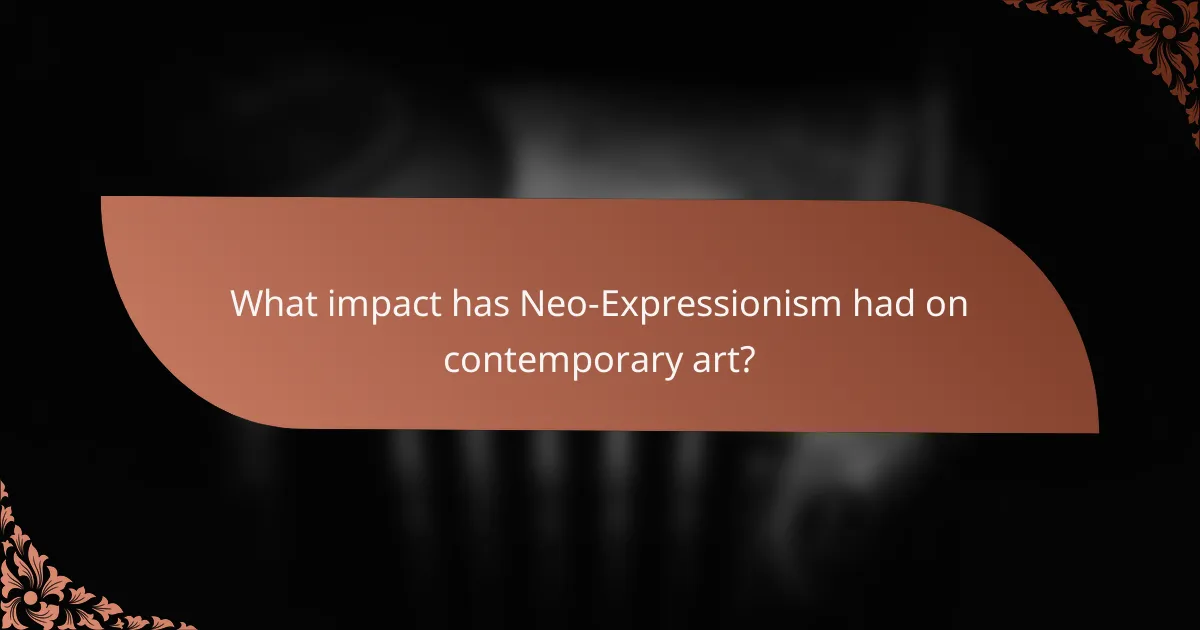
What impact has Neo-Expressionism had on contemporary art?
Neo-Expressionism has significantly influenced contemporary art by reviving emotional intensity and individuality. This movement emphasises bold colours, distorted forms, and personal narratives, challenging minimalist aesthetics. Influential artists like Julian Schnabel and Jean-Michel Basquiat have shaped this style, pushing boundaries and encouraging emotional expression. As a result, Neo-Expressionism has fostered a resurgence of interest in subjective experiences within art, impacting various genres and inspiring new generations of artists.
Which movements have been influenced by Neo-Expressionism?
Neo-Expressionism has influenced movements such as Transavantgarde, Street Art, and Postmodernism. These movements share a focus on emotional expression and vivid imagery, reflecting Neo-Expressionism’s core characteristics. Transavantgarde emerged in Italy, emphasising individual expression, while Street Art incorporates urban elements and social commentary. Postmodernism challenges traditional boundaries, resonating with Neo-Expressionist themes.
How does Neo-Expressionism reflect societal issues of its time?
Neo-Expressionism vividly reflects societal issues of its time through its emotional intensity and raw imagery. This movement emerged in the late 20th century, responding to political unrest, social upheaval, and existential crises. Artists like Julian Schnabel and Anselm Kiefer depicted themes of trauma and identity, often addressing the aftermath of war and cultural dislocation. The movement’s emphasis on personal expression highlights individual struggles, mirroring broader societal anxieties. As a result, Neo-Expressionism serves as a powerful commentary on the complexities of contemporary life, making it a crucial lens for understanding the era’s challenges.
What are the lasting legacies of Neo-Expressionism in art education?
Neo-Expressionism has significantly influenced art education by promoting emotional expression and individualism. This movement encourages students to explore personal narratives and diverse techniques. Artists like Jean-Michel Basquiat and Anselm Kiefer have inspired curricula that prioritise creativity and critical thinking. The legacy fosters a classroom environment that values subjective interpretation and emotional depth in artistic practice.
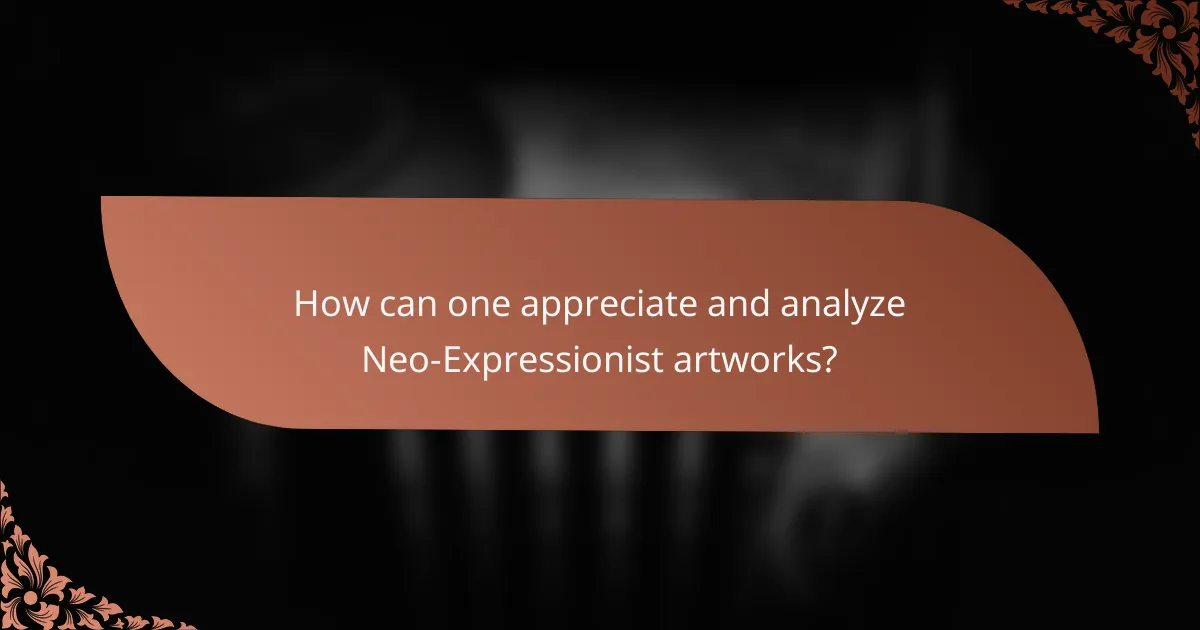
How can one appreciate and analyze Neo-Expressionist artworks?
To appreciate and analyse Neo-Expressionist artworks, focus on emotional expression, bold colours, and dynamic forms. Observe how artists convey personal and societal themes through their unique styles. Engage with the works by considering the historical context and the artists’ intentions, as this enhances understanding. Notable artists, such as Anselm Kiefer and Jean-Michel Basquiat, exemplify the movement’s depth and complexity. Their distinct approaches highlight the movement’s root attributes, like emotional intensity and abstraction, while also showcasing unique traits that set them apart.
What techniques should be considered when viewing Neo-Expressionist pieces?
When viewing Neo-Expressionist pieces, consider techniques that enhance emotional engagement and interpretation. Focus on the use of colour, form, and texture, as these elements convey the artists’ intense feelings. Analyse the composition to understand the narrative behind each piece, noting how distortion and abstraction reflect personal or societal struggles. Pay attention to the context of the artwork, including the artist’s background and the historical moment, as these factors influence meaning. Lastly, embrace a subjective response, allowing your emotional reaction to guide your interpretation of the artwork.
How can understanding the artist’s background enhance the viewing experience?
Understanding the artist’s background enhances the viewing experience by providing context and depth to their work. Knowledge of an artist’s personal history, cultural influences, and societal challenges can reveal underlying themes and intentions. For instance, Neo-Expressionism often reflects artists’ emotional responses to contemporary issues, making their backgrounds crucial for interpretation. Recognising these connections fosters a deeper appreciation of the artwork’s significance and emotional resonance.
What are some common mistakes to avoid when interpreting Neo-Expressionist art?
Common mistakes when interpreting Neo-Expressionist art include overanalysing symbolism, ignoring emotional impact, and dismissing the artist’s intent. Viewers often focus too much on hidden meanings rather than the immediate emotional response the artwork evokes. Additionally, neglecting the context of the artist’s background can lead to misinterpretations. Another mistake is assuming all Neo-Expressionist works adhere to the same style, overlooking the unique attributes of individual artists.
